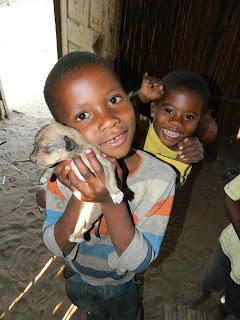 |
| Our project garden at CACHES just after planting corn. |
That´s Changana for.... Good Nutrition in Chicumbane.
That´s the name of the agriculture and nutrition project CACHES and I started in September through a Peace Corps Small Projects Assistance grant. The project was the brainchild of Nelio, one of the volunteers I work with at CACHES, and now he and I are the project coordinators working together to make the project a reality...
Our goals for the project are: Teach conservative agriculture to the community of Chicumbane, promote the planting of more nutritious plants and promote good nutrition in the community.
We have been working on the project for the past eight months, but it has just recently gotten underway...
April: I brought Nelio to PDM, a three-day Peace Corps sponsored conference on project design and management. At the conference we worked through the process of designing a project from start to finish.
May-June: Upon returning home from the conference, Nelio and I sat down and designed a project. We spent countless hours working our way through the project design process: developing goals and objectives, creating a timeline, planning out monitoring and evaluation and drawing up a budget. We took what we had learned at the conference and used it to create our own project focused on agriculture and nutrition.
July: Nelio and I submitted the grant to Peace Corps.
August: APPROVED. We heard back from Peace Corps that our grant was approved.
September: We opened a bank account for the grant funds. We met with local community-based organizations, Tsembeka and Chikuha, about their involvement in our project. We sat down with the community leaders to inform them about the project. Things started coming together...
October: CACHES, Tsembeka and Chikuha all prepared their land to plant a garden.
 |
| Nelio demonstrating how to make a tip-tap, hand washing station. |
November: However, it was not until November that we first received our grant money. Believe it or not, the government shutdown had something to do with the delay in receiving our funds... Despite the delay, we jumped into gear buying necessary equipment and material and hosting agricultural trainings weekly at CACHES for the 15 volunteers who signed on to work with our project. Every Friday we hosted a training covering permagardening; conservative agriculture; compost piles and making a tip-tap, a hand washing station.
 |
| One of our Friday morning agriculture trainings at CACHES. |
 |
| The volunteers learning to make a compost pile. |
December: We continued to host trainings for the first two weeks in December. On Friday, Dec. 13th, we planted corn in our garden. And in addition, we planted some more nutritious plants, including chaya, moringa and katuk. We received all of these plants from my friend Evan´s organization Mozaic in Manjacaze. They hosted the nutrition training I attended in November. Moringa is known as the miracle plant here being very easy to grow and containing lots of vitamins, minerals and protein. Chaya and katuk also contain more vitamins and minerals than other green leaf plants commonly eaten here. One of our goals throughout this project is to introduce more people to the nutritional value of these plants.
The project is now on holiday break until January 10th. As I learned last year, Mozambique takes ferias (holidays) very seriously. Not much in terms of work gets done from mid-December until mid-January. So instead of battling the holidays, we just accepted them and decided to take holidays ourselves. So starting in January we will continue our project. At that point, we will work with our volunteers who attended our agricultural trainings in November and December to go out into the community to teach families in the community how to do conservative agriculture within their own homes. After that point, we will then start nutrition trainings for our volunteers again. And once we complete our nutrition trainings, we hope to have health fairs for our community at CACHES. (More details to come once they are up and running.)
 |
| Distributing plants including chaya, moringa and katuk, to our volunteers. |
So far, the project seems to be going pretty well. It has definitely been a learning process for Nelio and myself, but for the most part it is going well. Even though every training is set to start at 8 a.m., usually everyone shows up by 9 a.m. and we are able to get started. And as opposed to having five volunteers from each organization each week as we had hoped, we usually average about three volunteers from each organization. We opened our trainings up to members of the community so we have a consistent two members who participated in our trainings.But, I have learned these are minor aspects in the grand scheme of the project. What´s more important is that we are distributing the information to those who there and that we are meeting our objectives. My role has been very minor in actually facilitating with the trainings, which I am very happy about. Both Nelio, and another volunteer from CACHES, Paulo, have attended trainings with me on agriculture and nutrition, so they are primarily the facilitators. They like to remind me that my job is to handle snack. I can do that. No, but seriously, I work with them to plan beforehand, and then during the training, they take the lead. It is much more sustainable.
 |
| Faustino, one of our community volunteers planting his garden. |
So as we close out the year, I am content with how the project has gone so far, but I know it is just the beginning. There are definitely areas that need improvement and the bulk of the project is yet to come. So as they say in Changana, Catsonga (probably spelt wrong). . . .pouco a pouco. . . little by little. One step at a time.
































































